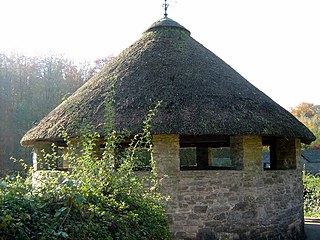 W
WSt Fagans National Museum of History, commonly referred to as St Fagans after the village where it is located, is an open-air museum in Cardiff chronicling the historical lifestyle, culture, and architecture of the Welsh people. The museum is part of the wider network of Amgueddfa Cymru – National Museum Wales.
 W
WDenbigh Cockpit is a reconstructed building at St Fagans National Museum of History in Cardiff, the capital of Wales. The cockpit formerly stood in the yard of the Hawk and Buckle Inn at Vale Street, Denbigh, and is thought to date from the late seventeenth century. It is a Grade II listed building.
 W
WEsgair Moel is a woollen mill, originally built in the early 18th century and now reconstructed at St Fagans National Museum of History in Cardiff, Wales. It was the second historic building to be erected at the museum.
 W
WGwalia Stores is a retail premises originally built at Ogmore Vale, Glamorgan, in 1880 and currently located at St Fagans National History Museum, Cardiff, Wales.
 W
WHendre'r Ywydd Uchaf is an early 16th-century cruck house, originally constructed near Llangynhafal, Denbighshire, and now located at St Fagans National History Museum in Cardiff, Wales. One of the interior wooden beams has been dated to the year 1508, using dendrochronology. The house has five bays, two of which would have been used for livestock, and an open hearth. It was designated a Grade II listed building on 10 June 1977.
 W
WThe House of the Future, more recently renamed Ty Gwyrdd, is a modern house located in the St Fagans National History Museum on the western edge of Cardiff, Wales. Completed in 2000, it was originally a showcase of the latest green building technologies, but was later transformed into an education centre. It was described by architectural writer Owen Hatherley as "a rather ambitiuous gesture for a place devoted to reconstructing the past".
 W
WKennixton Farmhouse is a 17th-century farmhouse originally built at Kennexstone, Llangennith, Gower, and currently located at St Fagans National History Museum, Cardiff, Wales. It is a Grade II listed building.
 W
WMelin Bompren is a water-powered corn mill, originally located at Cross Inn, Cardiganshire, Wales, but now at the St Fagans National History Museum, Cardiff.
 W
WOakdale Workmen's Institute is a public building originally erected at Oakdale, Caerphilly, Wales, in 1917 and now located at St Fagans National Museum of History, Cardiff.
 W
WSt Fagans Castle is an Elizabethan mansion in St Fagans, Cardiff, Wales, dating from the late 16th century. The house and remaining medieval fortifications are Grade I listed. The grounds of St Fagans Castle now contain St Fagans National Museum of History.
 W
WSt Teilo's Church is a historic building originally located at Llandeilo Tal-y-Bont near Pontarddulais and now reconstructed at St Fagans National History Museum in Cardiff, Wales.
 W
WThe Tudor Trader House is a 16th-century house originally constructed at Haverfordwest, Pembrokeshire, Wales, and now relocated at St Fagans National History Museum, Cardiff.
 W
WThe Vulcan Hotel is an historic hotel and public house, that was located in Adamsdown suburb of Cardiff, South Wales. Scheduled for demolition in 2009, after a long public campaign to preserve what had become one of Cardiff's oldest working public houses, in 2012 it was donated to the National History Museum at St Fagans, where it is being reconstructed.